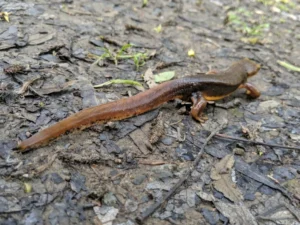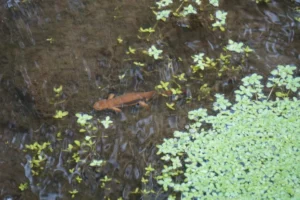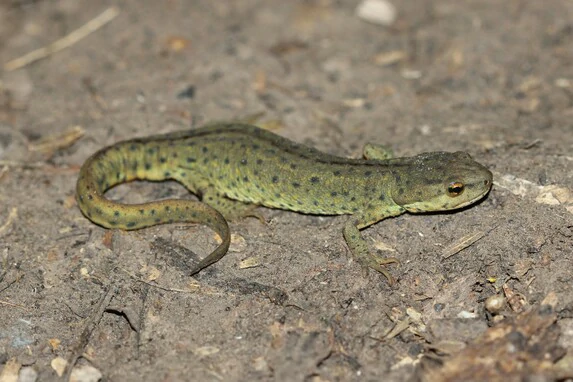Have you ever walked by a pond or a damp forest floor and thought, “Where are all the newts?” You know they’re around, but actually seeing one feels like a lucky moment.
The best time to spot newts is at dawn, dusk, or on humid and rainy days. That’s when they’re most active. Young ones usually move in the morning, while adults come out more in the evening. The season, the weather, and even the temperature all play a big role in whether you’ll see one.
Why Dawn and Dusk Work Best for Newts
Newts like low light. They’re what scientists call crepuscular, which just means they’re most active at dawn and dusk. But why those hours?
In the morning, the air is cool and damp. That’s perfect for newts, because their skin dries out fast if it’s hot.

Predators like birds aren’t busy yet, so newts can move around more safely. Bugs are also buzzing around in the morning, giving them plenty of food.
Evening is another safe window. The sun drops, the air cools down, and predators settle for the night.
You might see Eastern newts slipping out from under wet leaves and gliding across the water, snapping up tiny insects or larvae.
Young efts often stay near the pond’s edge, moving carefully while keeping close to cover.
If you go for a walk at sunrise or sunset, you’ve got a good shot at seeing them out in the open.
How Weather Changes Newt Activity
Weather makes a big difference too. Newts are very sensitive to moisture, because their skin has to stay damp to help them breathe and stay protected.
-
Rainy or humid days: Newts come alive. They leave their hiding places and wander across damp ground, logs, or shallow water. Even light rain can get them moving, sometimes for feeding or even mating.
-
Hot, dry afternoons: Newts hide. They crawl under logs, leaves, or rocks, and wait it out in the shade until conditions improve.
For example, after a summer rain, a pond that looked empty an hour ago might suddenly be crawling with bright orange juveniles and adults gliding through the shallows.

Even small changes in weather can make the difference between seeing none or seeing plenty.
Do Young and Adult Newts Show Up at Different Times?
Yes. Young newts, like the bright orange efts, usually move in the early morning. They wander damp forest floors near ponds or streams.
They’re tiny and stand out in color, so they’re extra careful, moving slowly, staying near cover, and pausing often.

Adults, especially when it’s breeding season, are more active in the evening or at night. They travel between water and land looking for mates or safe egg-laying spots.
You might see a juvenile pausing to sniff damp soil or poke around for tiny insects.
At the same time, an adult male might dart through the water, showing off his bright belly to get a female’s attention.
How the Seasons Change What You See
The time of year matters just as much as the time of day.
-
Spring: Newts wake up from hibernation and start looking for mates and egg-laying spots. This is the best season to see them, especially at dawn or dusk.
-
Summer: Adults are very active in the evenings, hunting and patrolling pond edges. Rainy summer nights are especially good.
-
Fall: They start slowing down. Young ones may still crawl around on moist nights, but adults stay hidden more often.
-
Winter: Many newts hibernate or burrow. Sightings become rare until spring returns.
If you know what season it is, you’ll have a much better chance of knowing when to look.
Where to Look for Newts
It’s not just about when, it’s also about where. Newts like moist, protected spots.
-
Ponds and shallow streams: Adults often swim along the edges or crawl between land and water.
-
Damp forest floors: Young efts explore leaf litter, moss, or spaces under logs in the morning.
-
Under rocks, logs, and leaves: Even in dry weather, these hiding spots can hold resting newts.
A quiet woodland pond with mossy edges might show you juveniles in the morning and adults cruising the water at dusk.
How to Watch Newts Without Bothering Them
Newts are delicate, and handling them can harm their skin or stress them out. The best way to enjoy them is to watch without touching.
Tips for safe watching:
-
Move slowly and quietly so you don’t scare them.
-
At night, use a soft flashlight or a red light.
-
Keep your distance so they act naturally.
-
Take photos or notes instead of picking them up.

This way, you’ll see their natural movements without disturbing them.
Timing and Patience Show You Their Hidden World
Finding newts isn’t about luck, it’s about timing, weather, and patience. If you go out at the right hours, especially after rain, you can see:
-
Young efts crawling slowly across leaf litter in the morning.
-
Adults gliding between water and land at dusk.
-
Spring courtship, with males showing off their colors.
-
Quiet feeding, like snapping tiny insects or larvae.
Be patient. Newts often pause or hide for a bit, then start moving again. If you wait, you’ll catch more of their natural behavior.
Fun Facts for Newt Watchers
-
Juvenile efts move slowly and stick close to cover.
-
Adults swim with sudden bursts of tail-powered speed.
-
Rainy nights bring out far more newts than dry ones.
-
Watching them in natural light shows behavior you won’t see in captivity.
Even a short watch can show you a lot about how they live, eat, and survive.
Conclusion
So, when’s the best time to see newts? Dawn, dusk, rainy days, and humid nights. Young ones prefer mornings, adults prefer evenings, and both depend on moisture and season.
If you go out at the right times and move carefully, you’ll see newts in their natural rhythm, feeding, exploring, and sometimes courting.
Next time the air is cool and damp, take a closer look. You might find newts living out their secret world right in front of you.
Hi, my name is Ezra Mushala, i have been interested animals all my life. I am the main author and editor here at snakeinformer.com.

